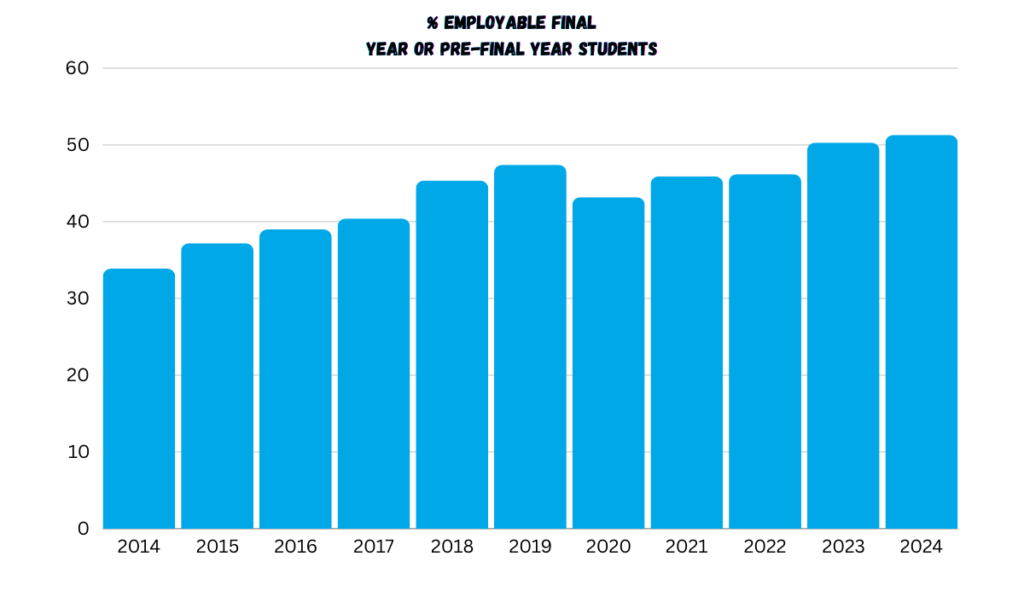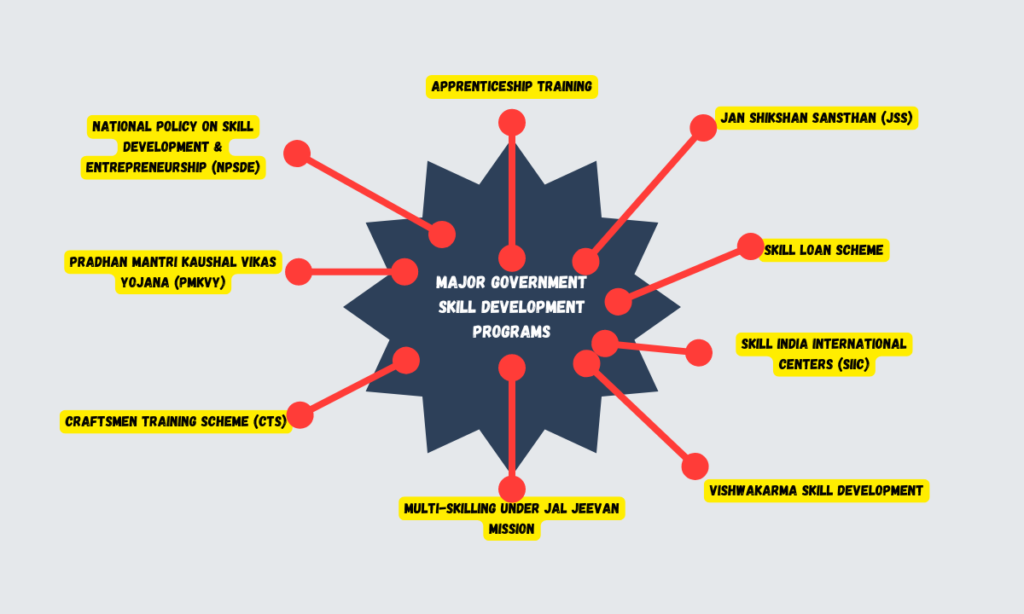India is experiencing a unique moment in its history. With one of the youngest populations globally, the country stands at the brink of a significant opportunity. However, to fully tap into this potential, we need to bridge the skill gap in our workforce. That’s where initiatives like “Skill India” come into play, aiming to empower millions with the skills they need for today’s job market.
Table of contents
- India’s Demographic Advantage and Skill Development
- Challenges in India’s Skill Development Sector
- Government Initiatives for Skill Development
- Focus on Employment and Skilling in Budget 2024
- Major Government Skill Development Programs
- Entrepreneurship Training and Support
- Skill India Digital Hub Platform
- Targeted Skilling Efforts in Diverse Sectors
- Latest Achievements in Skill Development
- Skilling India at Global Standards
- Partnering with Industry for Skilling
- Conclusion
- Reference:

India’s Demographic Advantage and Skill Development
India’s demographic dividend is a key asset. With over 65% of its population under the age of 35, there’s an immense workforce ready to contribute to economic growth. But here’s the catch—having a young population alone isn’t enough. We need to equip these young minds with the right skills to match industry demands. This is where skill development becomes crucial, helping transform potential into productivity.
| Aspect | Data |
|---|---|
| Total Population | 1.4 billion (approx.) |
| Percentage of Population Under 35 | Over 65% |
| Projected Workforce by 2025 | Over 1 billion |
| Current Workforce with Formal Skills | Only 4.69% (as of recent studies) |
| Industry Skill Gap | 70-80% of employers report skill shortages |
| Potential Contribution to GDP | Skill development could add $2 trillion by 2025 |
This data shows that while India has a large young population, there’s a significant skill gap that needs to be addressed to harness this demographic advantage effectively. With targeted skill development programs, India can potentially bridge this gap, leading to substantial economic growth.
Challenges in India’s Skill Development Sector
Despite significant progress, India’s skill development sector faces several challenges. The MSDE Annual Report sheds light on issues like outdated training methods, a lack of quality trainers, and the need for better infrastructure. Addressing these gaps is essential to build a comprehensive ecosystem that can support our young workforce.
Also Read उमर खालिद: चार साल से जेल में, क्या है पूरा मामला?
Government Initiatives for Skill Development
The government has been proactive in addressing these challenges. The Skill India Digital Platform is one such initiative, serving as a one-stop hub for skilling opportunities. It’s designed to provide accessible and quality training, aligning with the industry’s evolving needs. This platform and other programs have already made significant strides in skilling millions across the country.
The Skill India Digital Platform is a key initiative under the broader Skill India Mission, which was launched in 2015. This platform is designed to empower India’s youth by providing them with access to a wide range of skill development opportunities. Here’s a more detailed look at this initiative:
Key Features of the Skill India Digital Platform
- Comprehensive Training Programs: The platform offers a diverse array of training programs across various sectors, including IT, healthcare, manufacturing, retail, and more. These programs are designed to cater to different skill levels, from basic to advanced, ensuring inclusivity.
- Accessible Learning: One of the primary goals is to make skill development accessible to everyone, regardless of their location or socio-economic background. The digital nature of the platform allows individuals from remote and rural areas to access quality training resources.
- Industry-Relevant Courses: The platform works closely with industry experts and companies to ensure that the courses offered are in line with current industry demands. This ensures that learners acquire skills that are relevant and in demand, increasing their employability.
- Certification and Recognition: After completing the courses, participants receive certifications that are recognized by the industry. This adds value to their skill set and enhances their chances of securing better job opportunities.
- Career Guidance and Placement Support: The platform doesn’t just stop at training; it also provides career guidance and connects learners with job opportunities. This holistic approach ensures that individuals are well-prepared for the job market.
- Multi-Language Support: To cater to India’s diverse population, the platform offers courses in multiple languages, making it easier for learners to understand and absorb the content.
Impact and Progress
Since its launch, the Skill India Digital Platform has made a significant impact. Millions of individuals have enrolled in various courses, and many have successfully transitioned into the workforce. The platform has also been instrumental in upskilling the existing workforce, helping them adapt to new technologies and industry requirements.
Additionally, the government’s collaboration with private sector companies, industry bodies, and educational institutions has strengthened the platform’s offerings, ensuring that it remains relevant and effective in addressing the country’s skill gap.
The Road Ahead
While the Skill India Digital Platform has made considerable strides, the journey to a fully skilled workforce is ongoing. Continuous updates to the curriculum, the inclusion of emerging sectors like AI and cybersecurity, and ongoing partnerships with industry leaders are essential to keep pace with the evolving job market.
In summary, the Skill India Digital Platform is a pivotal part of India’s effort to transform its demographic advantage into a skilled workforce, ready to meet the challenges and opportunities of the 21st-century economy.
Also Read क्या आस्था केवल खास लोगों के लिए है? मुंबई के लालबागचा राजा में वीआईपी संस्कृति पर बढ़ा विवाद
Focus on Employment and Skilling in Budget 2024
Budget 2024 brought a renewed focus on skilling and employment. The introduction of a new Centrally Sponsored Scheme aims to create jobs while promoting skill development. Alongside, the revised Model Skill Loan Scheme offers financial support to students and trainees, ensuring that financial constraints don’t become a barrier to acquiring new skills.

Major Government Skill Development Programs
Several major programs are at the forefront of the Skill India mission. The National Policy on Skill Development & Entrepreneurship (NPSDE) sets the strategic framework, while the Pradhan Mantri Kaushal Vikas Yojana (PMKVY) offers short-term skill training programs. Other initiatives like the Craftsmen Training Scheme (CTS) and Jan Shikshan Sansthan (JSS) focus on vocational and adult education, ensuring a holistic approach to skill development.
| Skill Development Program | Objective | Key Features |
|---|---|---|
| National Policy on Skill Development & Entrepreneurship (NPSDE) | To provide a strategic framework for skill development | Focuses on both skill training and entrepreneurship development |
| Pradhan Mantri Kaushal Vikas Yojana (PMKVY) | To offer short-term skill training programs | Provides industry-relevant skill training with certification |
| Craftsmen Training Scheme (CTS) | To offer vocational training through ITIs | Provides long-term vocational courses in various trades |
| Jan Shikshan Sansthan (JSS) | To provide vocational and adult education | Offers skill training programs tailored for the informal sector |
| Skill Loan Scheme | To provide financial support for skill training | Offers loans to students and trainees for skill development courses |
| Skill India International Centers (SIIC) | To provide training that meets international standards | Offers globally recognized skill certifications |
| Apprenticeship Training | To provide on-the-job training through apprenticeships | Offers hands-on experience in various industries |
| Multi-Skilling under Jal Jeevan Mission | To prepare individuals for roles in water management | Focuses on skilling in the water sector, including plumbing and water supply |
| Vishwakarma Skill Development | To promote traditional craftsmanship skills | Focuses on skilling for traditional craftsmen in various sectors |
This table provides a clear overview of the major initiatives under the “Skill India” mission, outlining their objectives and key features to give readers a quick understanding of each program.
Entrepreneurship Training and Support
Skill development isn’t just about jobs; it’s also about fostering entrepreneurship. Institutes like NIESBUD and IIE play a crucial role in offering training and support to budding entrepreneurs. Their programs help individuals turn innovative ideas into successful businesses, contributing to economic growth and job creation.
Skill India Digital Hub Platform
The Skill India Digital Hub is a game-changer. This platform integrates various government initiatives and services, providing a seamless experience for learners. It offers courses, resources, and tools to help individuals develop skills that are in demand. Whether you’re a student, a professional, or an entrepreneur, this digital hub is designed to support your learning journey.
Targeted Skilling Efforts in Diverse Sectors
Skill India isn’t limited to just a few sectors. The initiative focuses on diverse areas, ensuring a well-rounded approach to skilling. For instance, multi-skilling under the Jal Jeevan Mission prepares individuals for roles in water management. There’s also a focus on Vishwakarmas, skilled craftsmen who play a vital role in traditional industries. The green hydrogen sector is another area receiving attention, aligning with India’s commitment to sustainable development.
Latest Achievements in Skill Development
Recent achievements in the skill development sector highlight the government’s commitment to enhancing the employability and skills of India’s youth. Here are some key developments:
- Launch of the Skill Loan Scheme
- Overview: The revised Model Skill Loan Scheme was launched to provide financial support for advanced skill courses. This initiative aims to reduce financial barriers for students pursuing high-demand skills.
- Key Features: The loan amount has been increased from ₹1.5 lakh to ₹7.5 lakh. This expanded financial support helps more students access quality training and acquire industry-relevant skills.
- World Youth Skills Day Celebrations
- Overview: On World Youth Skills Day, various programs and events were held to celebrate the achievements of young learners. The day not only recognized individual accomplishments but also highlighted the progress of national skill development initiatives.
- Significance: These celebrations help raise awareness about the importance of skills development and motivate more young people to engage in skill-building activities.
- Positive Growth in Apprenticeship Training
- Overview: The apprenticeship training program has shown significant growth, with an increasing number of apprentices engaged in various sectors.
- Current Status: As of July 2024, there are 2,77,036 apprentices, with a total of 7.46 lakh apprentices undergoing training. This growth reflects the expanding opportunities and increased industry participation in apprenticeship schemes.
- Direct Benefit Transfer (DBT) System
- Overview: The DBT system facilitates transparent and efficient disbursement of funds to apprentices. It ensures that stipends are directly transferred to apprentices’ bank accounts, reducing delays and improving financial management.
- Recent Achievements: From April to July 2024, the Government of India disbursed ₹122.36 crore in stipends through DBT, benefiting thousands of apprentices.
These achievements underscore the progress made in India’s skill development efforts, demonstrating a commitment to improving access to training, supporting young learners, and fostering a skilled workforce for the future.
Skilling India at Global Standards
To compete globally, India is raising its skill standards. The Skill India International Centers (SIIC) provide world-class training, helping individuals meet international job market demands. Collaborations with countries like Japan and the UAE enhance the quality of training and open up new opportunities for Indian workers abroad. Organizations like NSDC International Limited play a pivotal role in these efforts, ensuring that Indian talent is recognized and valued worldwide.
Partnering with Industry for Skilling
The success of Skill India hinges on strong industry partnerships. Collaborating with industry leaders ensures that training programs align with real-world needs. NSDC drives several industry-specific projects, while the Directorate General of Training (DGT) works closely with industries to enhance apprenticeship programs. These partnerships bridge the gap between training and employment, providing learners with the skills that employers are actively seeking.
Conclusion
Skill India has made significant strides in empowering the country’s youth with relevant skills. By addressing the challenges in the skilling ecosystem and building strong industry partnerships, India is on the path to becoming a global leader in talent. As we continue to develop and refine these programs, we can look forward to a future where every individual has the skills and opportunities to succeed.
Reference:
- https://www.indiabudget.gov.in/economicsurvey/
- https://pib.gov.in/PressReleaseIframePage.aspx?PRID=2035609#:~:text=Budget%20Estimates%202024%2D25%3A,receipt%3A%20%6025.83%20lakh%20crore
- https://pib.gov.in/PressReleaseIframePage.aspx?PRID=2035618
- https://www.indiabudget.gov.in/doc/budget_speech.pdf
- Monthly Summary for the month of July, 2024: https://www.skilldevelopment.gov.in/index.php/en/reports-documents/monthly-summary
